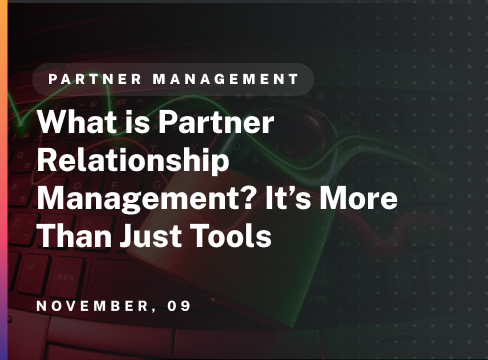When most people think of Partner Relationship Management (PRM), they picture a software platform – tools that track, manage, and optimize their partner relationships. But effective PRM goes far beyond just using the right technology. Sure, software can streamline and automate certain processes, but building strong, productive partnerships takes more than tools alone.
At its core, PRM is about building trust, setting clear goals, and maintaining open lines of communication. It’s about ensuring partners are well-trained, aligned with your values, and fully supported. The software? That’s just the scaffolding that helps reinforce these foundational elements.
In this blog, we’ll explore what partner relationship management really is and how you can use it to strengthen and support your partnerships.
What is Partner Relationship Management?
Partner Relationship Management (PRM) refers to the strategies, processes, and tools companies use to strengthen and optimize relationships with business partners.
The goal of PRM is straightforward: to make it as easy and beneficial as possible for partners to do business with you.
While tools can streamline this, a comprehensive PRM strategy involves intentional processes and open communication channels that foster trust, align goals, and ensure that partners feel fully supported.
Key components of PRM typically include:
- Partner Onboarding: Efficiently integrating new partners into the company’s ecosystem, providing them with the necessary resources and information to start selling or promoting products.
- Training and Certification: Offering educational materials and certification programs to ensure partners are knowledgeable about the products or services they represent.
- Sales and Marketing Support: Providing partners with access to marketing collateral, sales tools, and co-branding opportunities to aid in their promotional efforts.
- Performance Tracking: Monitoring and analyzing partner activities and outcomes to assess effectiveness and identify areas for improvement.
- Communication Channels: Establishing clear lines of communication to facilitate information sharing, feedback, and support between the company and its partners.
A well-implemented PRM strategy improves communication, increases partner engagement, and ultimately drives more revenue.
What is the Difference Between CRM and PRM?
At first glance, Customer Relationship Management (CRM) and Partner Relationship Management (PRM) might seem like two sides of the same coin. However, while both systems aim to improve business relationships, they operate in different arenas and serve unique purposes. Let’s break down what each system does and how they differ.
Managing Customer Relationships With CRM
CRM systems are designed to manage and streamline a company’s interactions with its customers. The focus here is on guiding a potential lead through the sales funnel – from the first touchpoint to closing the deal and beyond. A CRM helps sales and marketing teams:
- Track Leads and Prospects: CRMs collect data on potential customers, monitoring interactions and engagement.
- Nurture Customer Relationships: Automated follow-ups, personalized emails, and targeted campaigns are common features of a CRM, ensuring prospects move efficiently through the sales process.
- Optimize the Sales Funnel: By analyzing data, CRMs help identify bottlenecks and opportunities for improvement, making sales processes more efficient and effective.
Simply put, a CRM system is about understanding and engaging with your end customers to maximize sales opportunities and drive revenue.
What About PRM?
PRM systems, in contrast, are designed to manage and support a company’s relationships with external partners, like resellers, distributors, and affiliates. The goal is to empower these partners with the tools and resources they need to sell your products effectively. PRM systems typically include features like:
- Partner Onboarding and Training: Automating the onboarding process and offering comprehensive training to ensure partners are up to speed on your offerings.
- Sales and Marketing Resources: Providing partners with easy access to marketing collateral, co-branding opportunities, and deal registration portals.
- Performance Management: Monitoring partner performance, analyzing metrics, and offering insights to drive partner success.
- Communication and Collaboration Tools: Facilitating seamless communication between your company and your partners, ensuring they receive timely updates and support.
So, How Are They Different?
While CRM is designed to manage direct relationships with customers, PRM is focused on enabling and supporting business partners. Here’s a breakdown of how the goals and functions differ between the two:
- Building Strong Partnerships: CRM is designed for one-to-one customer interactions, aiming to build customer loyalty and increase sales. PRM focuses on building a network of partners through clear, strategic goals that align both parties’ interests, creating a foundation for long-term success.
- Communication Protocols: In CRM, communication is often automated and targeted at nurturing leads or moving customers through the sales funnel. PRM requires structured, ongoing communication to keep partners engaged and informed, with open channels for feedback that strengthen the partnership.
- Training and Enablement: CRM generally tracks customer engagement without including training. PRM, on the other hand, emphasizes partner training and enablement, equipping partners with the tools and knowledge to effectively represent the brand and boost sales.
- Performance and Accountability: CRM tracks metrics like customer satisfaction and conversion rates. PRM focuses on partner performance, using shared goals and regular feedback to help partners succeed and stay aligned with company objectives.
Put simply, CRM optimizes customer relationships, while PRM builds and supports a network of partners. Both can complement each other, but they serve different roles for your company’s reach.
What Does a PRM System Do?
We’ve touched on a few of the features that make up a PRM system. Now, let’s take a closer look at how PRM principles and software tools come together to make your partners’ lives easier.
While PRM strategies focus on building trust and aligning goals with partners, PRM software simplifies, automates, and supports these processes. Here’s a breakdown of the key functions of a PRM system:
1. Partner Onboarding and Training
Getting new partners up to speed is crucial, and a good PRM system makes this process straightforward. Through onboarding workflows, training modules, and certification programs, partners can quickly understand your products, brand guidelines, and sales processes.
This means they’re better equipped to represent your company accurately and sell effectively.
2. Sales and Marketing Resources
A partner relationship management system provides partners easy access to the resources they need to promote your products, including:
- Sales presentations
- Product sheets
- Co-branded marketing materials
Some PRM systems even include content syndication tools, automatically updating partner websites with the latest marketing collateral, saving time, and keeping messaging consistent.
3. Deal Registration and Opportunity Management
Deal registration tools allow partners to log sales opportunities, ensuring no overlap with your direct sales team and giving partners confidence that their leads are protected. PRM systems often include opportunity tracking features, helping you and your partners monitor deals through each pipeline stage.
4. Performance Management and Analytics
PRM systems provide dashboards and reports to track partner performance, from revenue generated to lead conversion rates. These insights allow you to see which partners excel and which may need additional support or resources.
For partners, access to their performance metrics can help them set and achieve goals, making the partnership mutually beneficial.
5. Communication and Support
Ongoing communication is vital to a successful partnership. PRM systems typically include messaging tools, updates, and support resources to keep partners informed and engaged.
By streamlining communication, a PRM system ensures that partners have quick access to the information they need, whether it’s a product update or a new sales strategy.
6. Incentive and Rewards Programs
Many PRM systems offer built-in tools for managing incentive programs, such as commission structures or rewards for top performers. These programs can be a powerful motivator, encouraging partners to stay engaged and drive more sales.
With a PRM, you can automate the tracking and distribution of rewards, creating a seamless experience for you and your partners.
A PRM system provides the structure and tools to build productive, long-term relationships with partners. It simplifies how you work together and creates an environment where partners feel valued, supported, and motivated to achieve success.
What is an example of a PRM System?
If you’re considering a PRM system, you’ll find several robust options designed to streamline your partner management efforts. Let’s look at some of the most popular PRM solutions and what they bring to the table:
1. Salesforce Sales Cloud PRM
Salesforce’s Sales Cloud PRM is a comprehensive solution that extends the capabilities of its CRM platform to manage partner relationships effectively. It offers features such as:
- Automated partner onboarding
- Lead distribution
- Deal registration
- Performance analytics
The system is designed to provide partners with the same tools and insights available to internal sales teams, facilitating seamless collaboration and driving channel sales growth.
2. PartnerStack
PartnerStack is a PRM platform specifically built for B2B SaaS companies, designed to deliver predictable revenue and accelerate growth for software businesses and their partners. It enables companies to launch and scale multiple partner programs side-by-side through one platform, including:
- Affilliates
- Referral partners
- Reseller partners
PartnerStack offers features such as automated partner onboarding, training, rewards, and payments, as well as tools for tracking program performance and metrics. The platform also provides access to a marketplace of over 80,000 active partners, helping companies connect with top software brands and start earning commissions.
3. Impartner PRM
Impartner PRM is a leading platform focused on optimizing partner engagement and accelerating revenue through indirect sales channels.
It provides a suite of tools, including:
- Partner onboarding
- Training modules
- Deal registration
- Marketing automation
Impartner’s solution is known for its scalability and ability to integrate with existing CRM systems, making it suitable for businesses aiming to expand their partner networks efficiently.
4. 360insights
360insights provides a comprehensive PRM solution with a focus on incentives and rewards management. Its platform includes tools for managing channel incentives, rebates, and promotions, helping companies motivate and engage their partners effectively.
360insights also offers analytics and reporting features to track the performance of incentive programs.
The platform also provides fund management capabilities, allowing companies to allocate and monitor market development funds (MDF) and co-op programs to support partner marketing initiatives.
5. Mindmatrix
Mindmatrix offers a comprehensive PRM solution that integrates partner relationship management, channel marketing, and sales enablement into a unified platform. Their platform provides tools for partner onboarding, training, sales and marketing support, and performance tracking.
With Mindmatrix, you can have a personalized approach with partner relationship management through customizable dashboards and content to meet the specific needs of partners. They also provide services to boost partner adoption and engagement, ensuring that partners are well-equipped and motivated to drive revenue.
6. Allbound PRM
Allbound is a user-friendly PRM platform designed to simplify partner engagement. It offers an intuitive partner portal, content management, and training modules, serving as a centralized hub for partners to access necessary resources.
Allbound’s focus on ease of use and seamless partner engagement makes it suitable for companies prioritizing straightforward collaboration with their partners.
7. ZINFI
ZINFI provides a Unified Partner Management (UPM) platform that includes applications for Partner Relationship Management (PRM), Partner Marketing Management (PMM), and Affiliate Marketing Management (AMM).
Their PRM platform offers modules for partner recruitment, onboarding, training, and management, as well as tools for sales and marketing support.
ZINFI’s scalability and flexibility allows organizations to tailor their partner management approaches based on regional and global needs. Their platform also includes analytics and reporting features to track partner performance and optimize partner programs.
8. Euler
Euler is a PRM solution designed to simplify partner management and collaboration. It offers features such as:
- Partner onboarding and training
- Deal registration
- Performance tracking
Euler aims to provide an intuitive and user-friendly platform for managing partner relationships and driving channel sales growth. The platform also includes tools for content management, enabling companies to share marketing materials and sales resources with their partners to support their efforts and ensure consistent messaging.
9. Unifyr (Formerly Zift Solutions)
Unifyr is a PRM platform that brings together various aspects of partner management, including onboarding, training, performance tracking, and marketing support. Their platform offers a seamless partner management experience, allowing organizations to manage multiple vendors and partners through a single platform. Unifyr emphasizes efficiency and optimization, providing tools for:
- Multi-vendor deal registration
- Marketing material selection
- AI functionality to build campaigns
Unifyr also offers an AI-enhanced agency marketplace and platform, supporting professional services across various SaaS sales and marketing automation platforms.
10. Magentrix PRM
Magentrix provides a cloud-based PRM solution emphasizing collaboration and customization. It includes automated onboarding, partner training, and customizable dashboards, allowing businesses to tailor the partner experience to align with their brand.
Magentrix’s integration capabilities with various CRM systems facilitate smooth data flow between internal teams and external partners.
Conclusion
With the right processes and tools for onboarding, performance tracking, and seamless communication, your partners can become a powerful extension of your sales force. This guide has laid out the essentials to help you understand PRM systems and choose the one that fits your needs. Take this insight and explore how PRM can elevate your partnerships and drive meaningful results for your business.
Join The 1850+ Leaders Transforming Partnerships
As a member of Partnership Leaders, you will:
- Build and learn with the top partner people at the best companies around the world.
- Increase your impact and accelerate your career with proven resources, tools, and best practices.
- Grow a network of peers, partners, and advisors with common objectives.
Effective partner relationship management is essential for building and sustaining strong, mutually beneficial partnerships. It involves streamlining communication, setting clear expectations, and leveraging data to optimize performance. Organizations that prioritize partner relationship management see improved collaboration and long-term success. Mastering this discipline enables teams to unlock greater value from their ecosystems. To better understand the responsibilities tied to these efforts, explore the role of partnership. It highlights how partner managers drive impact through structured relationship strategies.


